CogAT 1st Grade Practice Test
The first-grade CogAT, like the Kindergarten CogAT, assesses students’ developing comprehension and reasoning skills. Additionally, it evaluates critical thinking skills, quantitative reasoning, and the ability to detect relationships between figures and images. Although a first-grade student will encounter similar questions to a kindergartener’s, the content is slightly more advanced. Sometimes, a 1st-grade student will have developed the fine motor and visual-spatial reasoning skills to use the bubble sheet. TestingMom.com members have access to free bubble sheets. Therefore, if you join, you can assess whether your child is confident enough to use the bubble sheet on test day.
Here are several CogAT sample questions designed for the 1st-grade level. Each practice question will reflect a specific subtest that your child will come across.
Are you ready to get your child ready for the CogAT today? Begin your preparation now by signing up for our complimentary set of 100 practice questions!
1) Quantitative Battery – Number Puzzles
The CogAT Number Puzzles section evaluates a student’s quantitative reasoning and problem-solving skills. As first-grade students engage in this section, they face a series of mathematical puzzles and number sequences. Their objective is to discern the missing number or sequence pattern required to complete each puzzle. This test segment encourages students to think critically, analyze numerical information, and apply logical reasoning to solve mathematical problems effectively. Consequently, it serves as a crucial component in assessing a student’s quantitative cognitive abilities within the framework of the CogAT assessment. This helps educators and psychologists gain valuable insights into a student’s mathematical reasoning skills.
In this number puzzle subtest example below, there are 2 trains. Each must be pulling the same number of red “boxes”. The child’s task is to identify which train should replace the train(s) with a question mark. So, the train to the left of the chain is pulling the same number of red boxes as the train to the right of the chain.
Example #1:
Look at the example below. Do you see how the first train is pulling two cars with 9 red boxes? Now look at the second train. It is pulling one car with 0 red boxes. We need to add another car where the question mark is so this train will be pulling the same number of red boxes as the first train. Which car should we add so the second train will be pulling 9 red boxes?
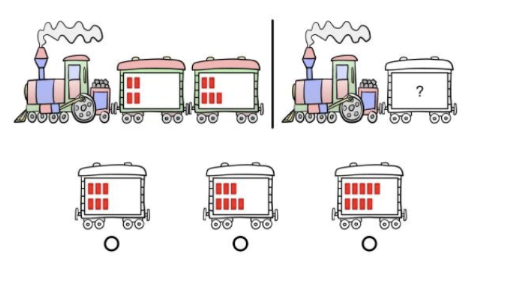
2) Non-Verbal Battery – Figure Classification
The CogAT’s Non-Verbal Battery Figure Classification evaluates a student’s non-verbal reasoning abilities. Within this section, students encounter a series of figures or shapes and must identify the figure that deviates from the rest based on a common characteristic or relationship. Furthermore, this segment of the test assesses a student’s capacity to discern patterns, similarities, and differences in visual information independently of language or verbal skills. Consequently, it encourages students to think critically and employ logical reasoning to resolve challenges, rendering it a fundamental component of the CogAT for assessing their non-verbal cognitive abilities.
In the figure classification subtest example below, students see two rows of figures. The top figures are alike in some way. The student must choose one figure from the bottom row that goes with the top figures in the same way that the figures on top go together.
Example #2:
Look at the shapes on top. They are alike in some way and so they belong together. Choose one shape from the bottom row that belongs with the figures on top.
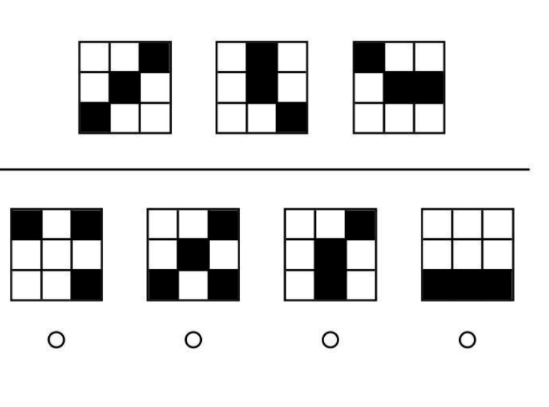
3) Verbal Battery – Verbal Analogy
The CogAT 1st Grade Verbal Battery Verbal Analogy assesses a student’s verbal reasoning skills at the 1st-grade level. In this section, students must identify the relationship between pairs of words. They must then select a word from a set of choices that exhibits a similar relationship to another pair of words. This portion of the test evaluates a student’s ability to understand and analyze word relationships, enhancing their verbal reasoning and language comprehension skills. It plays a crucial role in assessing a student’s cognitive abilities in verbal reasoning within the CogAT framework.
In the verbal analogies example below, the child sees a pair of items on top that have a certain relationship with each other. The child must determine how they are related. Then, the child must choose a picture from the possible answers that will have the same relationship with the picture on the bottom left.
Example #3:
Look t the two pictures on top. They go together in some way. Now look at the picture in the bottom box, and then look at the answer choices. Do you see a picture among the answer choices that goes with the picture on the bottom the same way the pictures on top go together?
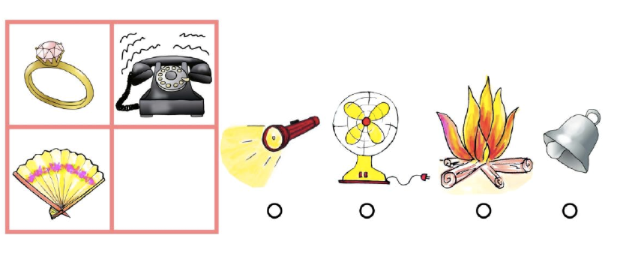
4) Quantitative Battery – Number Series
The CogAT Quantitative Battery Number Series evaluates a student’s quantitative reasoning skills. Within this section, students encounter a series of mathematical puzzles and number sequences. Their objective is to discern the underlying pattern or rule governing the sequence and forecast the subsequent number in the series. This segment of the test assesses a student’s capacity to identify and apply mathematical patterns, sequences, and relationships, thereby enhancing their quantitative reasoning and problem-solving capabilities. It stands as a pivotal element of the CogAT, contributing significantly to the assessment of a student’s cognitive abilities in the realm of quantitative reasoning.
In the number series subtest, the child sees an abacus with one rod missing. The child needs to review the first five rods and look for a pattern or rule. Then the child should choose the sixth rod that would continue to pattern or follow the rule in the sixth place.
Example #4:
Look at the example below. This is an abacus. The beads in the first 5 rods form a pattern or follow a rule. The beads in the sixth rod are missing. Can you choose the rod that goes in the sixth place that would complete the pattern or follow the rule?
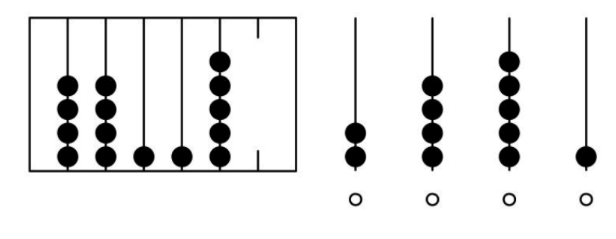
5) Non-Verbal Battery – Paper Folding
In the example below, the child observes a series of pictures depicting the folding of a piece of paper. Subsequently, one or more holes get punched into the paper. The child’s task is to choose the answer that illustrates what the paper will look like when unfolded.
Example #5:
Parent say to your child: Take a look at the pictures across the top. They show a piece of square being folded. Then, one or more holes are punched in the folded piece of paper. Can you point to the answer that shows what the square piece of paper will look like when it is unfolded.
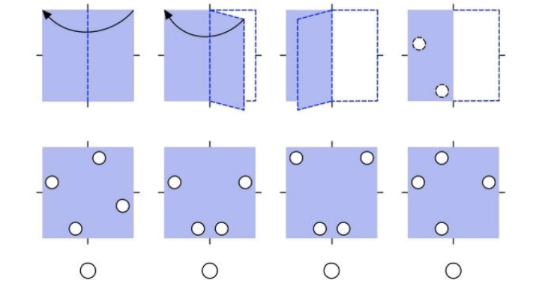
Answers:
1) Option 3 – with 9 red boxes
2) Option 3 – always has a middle black square; 3 squares are black
3) Option 2 – the fan
4) Option 3 – a rule of each number repeating twice: 4,4,1,1,5,5
5) Option 2
If you’re seeking assistance with CogAT preparation, Testing Mom Online Tutoring is here to help. We understand the importance of nurturing cognitive development and achieving success in assessments. Our team of expert tutors specializes in CogAT preparation and can provide the guidance and support needed for your child’s success. Schedule a FREE consultation call with one of our experts today to give your child the advantage they deserve.
See if TestingMom.com supports your child’s test by your school district. If you don't see your child's school district listed, check with us! We have practice for other tests as well.



Tell us about your experiences
31 Responses
Lynn
I am surprised as to how many that I got wrong as an adult. I think it’s good brain workouts. I also think that it’s very important for kids to practice/ study before each test. For the teachers to tell the kids the day before testing that they don’t need to study for these test is wrong. We all as parents want our kids to be prepared for what they are going to be tested for. Same with anything in life. We all like to be prepared. Thanks for the free practice sheets.
david
I love it.
Yale.Rebecca
A long way, you can finish step by step, and then you can’t reach without a foot
swapnaswamy@gmail.com
These are good practice questions
marilynjs@leeschools.net
I can’t get to the 100 free practice questions, when I click on the sign, nothing happens. Please include a direct link.
TestingMom.com
Thank you for reaching out to us! You can access our 100 free interactive questions here: https://www.testingmom.com/buy-now/?free-questions=1
All the best,
Marcus
Lidia Zerga
I like cogat test
Lidia Zerga
i love it
kumar.gejara@gmail.com
I liked it and it gives more education and more interesting – kindergarten student Sourish Gejara
mkapoor7@yahoo.com
I am unable to get the free practice test for Cogat 1st grade
Lavanya
Very helpful
Kavita
Great experience! I think it’s very good for brain exercise and knowledge for kids.
dhanijamb89@gmail.com
very good
claudel
I am interested in it
TestingMom.com
Hi Claudel –
Please email us at help@testingmom.com with any questions you might have!
All the best,
Marcus
Junlei
Good question!
hcps-Narangr@henricostudents.org
good!
anukolte123@gmail.com
Not getting free 100 questions
TestingMom.com
Thank you for reaching out to us.
When you login to your free TestingMom account, on the left hand side of the page, you’ll see a link for our 100 Free Questions.
All the best,
Marcus
Kavita
Hi… would like to use your help
TestingMom.com
Hi Kavita –
Feel free to call us at 877-609-6203 or email us at help@testingmom.com. We’re here to help 7 days a week!
All the best,
Marcus
griffin303@msn.com
I’m confused how to get the 100 free practice questions. It said sign up so I did but now it’s saying sign up again?
JC
My son is going to be tested for the gifted and talented program and I want to help prepare him for the CoGAT test.
TestingMom.com
Great! Sign-up for the 100 free questions to get started with CogAT prep!
Haneefah
Interesting
lbuchheit@pcsd32.com
I am looking for the 100 free practice cogat questions but cannot locate them as I have in the past. Can you please help?
Gplips@gmail.com
good question and my son find its very interesting and having fun to solve it. 🙂
padmagsri@gmail.com
How to access sample cogat ( for first grade ) test papers for free?
I’ve been a member since last year
TestingMom.com
Hello,
Please reach out to our Parent Success Team at help@testingmom.com or by calling (877) 609-6203. They will be more than happy to assist you!
annemarielaurel@yahoo.com
Extremely helpful examples! Thank you 🙂
Lidiaaaaaaaaaaaaaaaaaaa
I haven’t been doing cogat. Cogat is a great way to help you go into gifted.